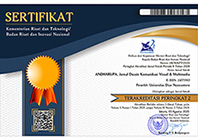Katalog sebagai Media Promosi bagi UMKM Koelon Kalie Krobokan Semarang
DOI:
https://doi.org/10.33633/andharupa.v2i02.1206Abstract
AbstrakSampah merupakan zat yang bersifat organik maupun anorganik yang dihasilkan dari setiap aktifitas manusia, seperti rumah tangga, industri, maupun komersil. Persoalan sampah di Indonesia, terutama di perkotaan merupakan masalah serius. Dinas Kebersihan Kota Semarang mencatat bahwa sampah perkotaan dari tahun ke tahun semakin meningkat seiring laju pertumbuhan jumlah penduduk. Sampah mengakibatkan permasalahan yang komplek, antara lain pembuangan sampah liar yang dapat menimbulkan berbagai penyakit, kota kotor, bau tidak sedap, mengurangi daya tampung sungai dan lain-lain. Tahun 2012, berdiri UMKM “Koelon Kalie†yang bertujuan meningkatkan pendapatan masyarakat dengan mengelola sampah plastik menjadi produk yang mempunyai nilai jual. Permasalahannya adalah belum adanya kegiatan promosi yang dilakukan dan hanya melalui mulut ke mulut konsumen dalam memasarkan produk. Media katalog merupakan media yang terjangkau dan efektif. Di dalam media katalog berisi informasi mengenai produk. Informasi yang dicantumkan yaitu nama, spesifikasi, dan harga produk tersebut. Gambaran produk dapat dilihat dengan jelas melalui informasi foto produk yang ditampilkan di media katalog. Berkebalikan dengan media mulut ke mulut yang hanya bisa didengarkan tanpa adanya gambaran produk dengan jelas. Melalui media katalog, konsumen mendapat informasi lebih jelas mengenai gambaran produk olahan sampah plastik. Kata Kunci: katalog, media promosi, UMKM  AbstractTrash are an organic and inorganic substance that generated from any human activity, such as household, industrial, and commercial. Trash issues in Indonesia, especially in urban area is a serius problem. Department of Semarang City Sanitation noted that urban trash from year to year increases along with population growth rate. The trash resulting complex problems, such as illegal waste disposal, appear various diseases, dirty city, odor, reduce the capacity of river and others. In 2012, arise MSMEs “Koelon Kalie†wich aim to increase public revenue by managing plastic waste into a products that can be sold. The problem it’s not carry out promotional activities and only through word of mouth in the consumer products market. Catalog is a affordable and effective tool. Catalog contains information about products, such as name, specifications, and price. Products overview can be seen clearly through the picture information displayed in the catalog. Opposite to Word of Mouth that can only be heard and can not be seen the product picture. With catalog, consumers get more information on a product overview of plastic waste processed products. Keywords: catalog, promotion media, MSMEsReferences
Anggraini, Nasution. (2013). Peranan Kredit Usaha Rakyat (KUR) bagi Pengembangan UMKM di Kota Medan (studi kasus Bank BRI). Jurnal Ekonomi dan Keuangan Vol. 1, No. 3. Medan: Jurnal USU
Arikunto, Suharsimi. (2006). Prosedur Penelitian Suatu pendekatan Praktik. Jakarta; PT Rineka Cipta
Artiningsih, N. K. (2008). Peran Serta Masyarakat Dalam Pengelolaan Sampah Rumah Tangga (Studi Kasus Di Sampangan Dan Jombang, Kota Semarang). Universitas Diponegoro:Semarang.
Becik, B. S. (2012, Maret 8). Bank Sampah Resik Becik (Gerakan Bersih Kreatif Bersama Ciptakan Kemakmuran) URL:http:// www.banksampahrb.blogsopt.co.id [Diakses pada 7 Juli 2016]
Hasugian, J. (2009). Katalog Perpustakaan: Dari Katalog Manual Sampai Katalog Online (OPAC). Medan: USU Digital Library.
Nazir, Mohammad, (1988) "Metode penelitian " Jakarta: Ghalia Indonesia
Satori, R. A. Mohamad. (2010). Pendampingan Usaha Masyarakat Dalam Memanfaatkan Sampah di Desa Manis Lor Kab. Kuningan. Prosiding SNaPP, (pp. 150-179).
Simamora, B. (2001). Memenangkan Pasar dengan Pemasaran Efektif dan Profitable. Jakarta: Gramedia Pustaka Utama.
Sugiyono. (2009). Metode Penelitian Kuantitatif Kualitatif. R & B. Bandung
Downloads
Published
Issue
Section
License
Copyright (c) 2016 ANDHARUPA: Jurnal Desain Komunikasi Visual & Multimedia

This work is licensed under a Creative Commons Attribution 4.0 International License.
Authors who publish with this journal agree to the following terms:
- Authors retain copyright and grant the journal right of first publication with the work simultaneously licensed under a Creative Commons Attribution License that allows others to share the work with an acknowledgment of the work's authorship and initial publication in this journal.
- Authors are able to enter into separate, additional contractual arrangements for the non-exclusive distribution of the journal's published version of the work (e.g., post it to an institutional repository or publish it in a book), with an acknowledgment of its initial publication in this journal.
- Authors are permitted and encouraged to post their work online (e.g., in institutional repositories or on their website) prior to and during the submission process, as it can lead to productive exchanges, as well as earlier and greater citation of published work (See The Effect of Open Access).















